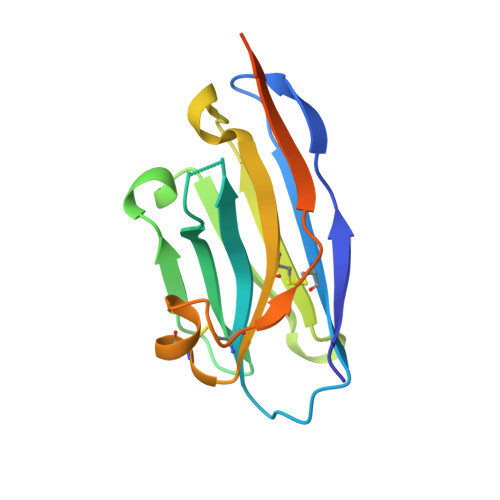Structural basis of VHH-mediated neutralization of the food-borne pathogenListeria monocytogenes.
King, M.T., Huh, I., Shenai, A., Brooks, T.M., Brooks, C.L.(2018) J Biol Chem 293: 13626-13635
- PubMed: 29976754
- DOI: https://doi.org/10.1074/jbc.RA118.003888
- Primary Citation of Related Structures:
6DBA, 6DBD, 6DBE, 6DBF, 6DBG - PubMed Abstract:
Listeria monocytogenes causes listeriosis, a potentially fatal food-borne disease. The condition is especially harmful to pregnant women. Listeria outbreaks can originate from diverse foods, highlighting the need for novel strategies to improve food safety. The first step in Listeria invasion is internalization of the bacteria, which is mediated by the interaction of the internalin family of virulence factors with host cell receptors. A crucial interaction for Listeria invasion of the placenta, and thus a target for therapeutic intervention, is between internalin B (InlB) and the receptor c-Met. Single-domain antibodies (V H H, also called nanobodies, or sdAbs) from camel heavy-chain antibodies are a novel solution for preventing Listeria infections. The V H H R303, R330, and R326 all bind InlB with high affinity; however, the molecular mechanism behind their mode of action was unknown. We demonstrate that despite a high degree of sequence and structural diversity, the V H H bind a single epitope on InlB. A combination of gentamicin protection assays and florescent microscopy establish that InlB-specific V H H inhibit Listeria invasion of HeLa cells. A high-resolution X-ray structure of V H H R303 in complex with InlB showed that the V H H binds at the c-Met interaction site on InlB, thereby acting as a competitive inhibitor preventing bacterial invasion. These results point to the potential of V H H as a novel class of therapeutics for the prevention of listeriosis.
Organizational Affiliation:
From the Department of Chemistry, California State University, Fresno, California 93740.















